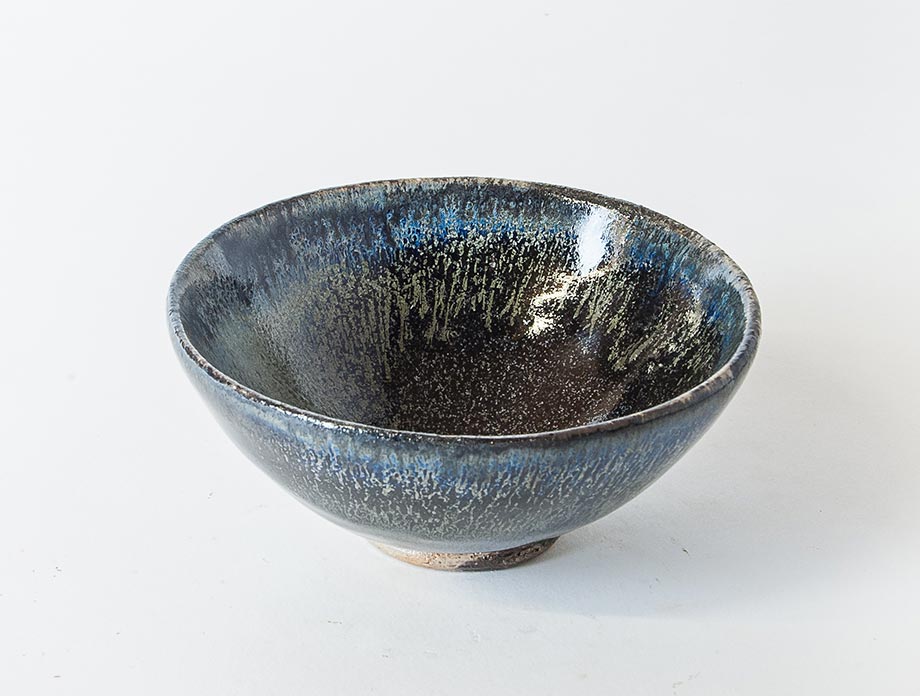It seems strange in one sense to be writing retrospectively, writing about a ‘retired’ potter, one who has decided now, after over half a century, to stop making. In March 2020, just as our first covid lock-down in the U.K. began, his final exhibition opened at Goldmark Gallery in Rutland. Hardly auspicious timing, but in the event it was a sell-out show and very much a celebration of one of Britain’s major post-war potters. Here is a man who physically and artistically has never done anything by halves. He has been so committed to each aspect of process and production, and because of the scale of much of his work, and his refusal to take easier shortcuts (he has always preferred the steeper climb; “I don’t want people to feel sorry for me…it was my choice”), his body is telling him to take things easier now.
Bayer has remained famously ambitious for his art, seeking to explore the nuances and idiosyncrasies of wood-firing to consolidate and add richness to his strong simple forms, often monumental in size. This has been, in a literal sense, slow-burn work, where the role of the firing is integral, and as distant from the sometimes anaemic results of an electric kiln as one is likely to find. He is just as much a clay potter as a fire potter though, one who loves the face and character of the material, and often eschews glazes, and when they are used, his preference is for quiet and understated ones, restrained kaki’s and celadons along with clay slips.
Every potter has his or her own preferences when it comes to placing work in the kiln, and again Bayer has been drawn to the riskier options
Bayer’s firings, latterly at Kigbeare, on the edge of Dartmoor in England’s West Country, were part and parcel with what he regards as a self-confessed madness in his method. At Kigbeare he built and shared a large anagama kiln with other potters who occupy the community of workshops there. This proved ideal for sharing out the firing shifts too, over a period of some five days, and for Bayer actually part of a four week process, if one includes glazing and packing. It is a type of long-haul oxidation and reduction that achieves the best results, surfaces that soften and elaborate the disciplined contours of his throwing, objects that already look weathered because of the atmospheric variance of the kiln. It is a complex balancing of elements, of careful placement and monitored firing strategy, a process Bayer compares to the intricacies of a sort of ‘three-dimensional chess’.
Every potter has his or her own preferences when it comes to placing work in the kiln, and again Bayer has been drawn to the riskier options, attracted to the back and front of the kiln, particularly the fluctuations of the firebox, where he has often placed big pots, just to add to the potential dangers of loss. As the culture of wood-firing, notably anagama, became increasingly popular in the West, so Bayer has appreciated more and more the aesthetic benefits of lengthier time in the kiln, adding so much to the character, depth and patina of his pots. In the process those losses have been high, but the pots that have survived are often magnificent, so the difficulties of the journey have been worth it.
His glazes may be few and very reserved, but there are a remarkable range of effects because of the interactions with falling wood ash and the vagaries of temperature. By often firing jars and bottles on their sides the fly-ash runs from one side of a pot’s belly to the other, so giving a contrary sense of movement to a rising form, with shell impressions and other markings adding their own sense of punctuation, a kind of surface mapping. Bayer has always enjoyed the decorative and expressive effects that result naturally in the making, the scars and colourations which make each pot so individual.
Wood-firing is a process often taken to excess. The clarity of a pot can be surrendered to the seductions of overly rich ash-deposit effects (the phrase ‘too much of a good thing’ springs to mind). However Bayer has been consistently faithful to what Michael Cardew memorably called ‘the majesty of form’, to its shape and contours, from his monumental garden jars with their echoes of African and Chinese vessels, to his smaller delicate bottles and bowls, with their own Oriental overtones. But there is always the danger of over-talking influences too, and Bayer has been one of a relatively small group of ‘traditional’ potters who has created his own unmistakable brevity of language, one for our own time. These are modern objects.
Like the late Richard Batterham his repertoire of shapes has been deliberately limited, as both potters have demonstrated how much is gained by gauging and re-gauging the endless possibilities and surprises not only of developed ideas in form, but the transforming character of glaze, slip and kiln alchemy. What results is a particular unity in the work, where each piece is closely related, one to another, where scale varies but there is this strong sense of connection in design and detail, where the tempo of batch making creates what the painter and critic Patrick Heron called ‘submerged rhythm’. Svend Bayer may sometimes feel as if, over the years, he has made a rod for his own back, but in choosing the hard way, it has resulted in magisterial pots which are at once powerful and intimate.
Note from the Editor: Svend Bayer is no longer involved with the kiln he built at Kigbeare.









David Whiting is a writer and curator, and a member of the International Association of Art Critics.
Images and video: Copyright Vanessa Champion
Woodfiring.com thanks the Goldmark Gallery for their collaboration in the preparation of this article.